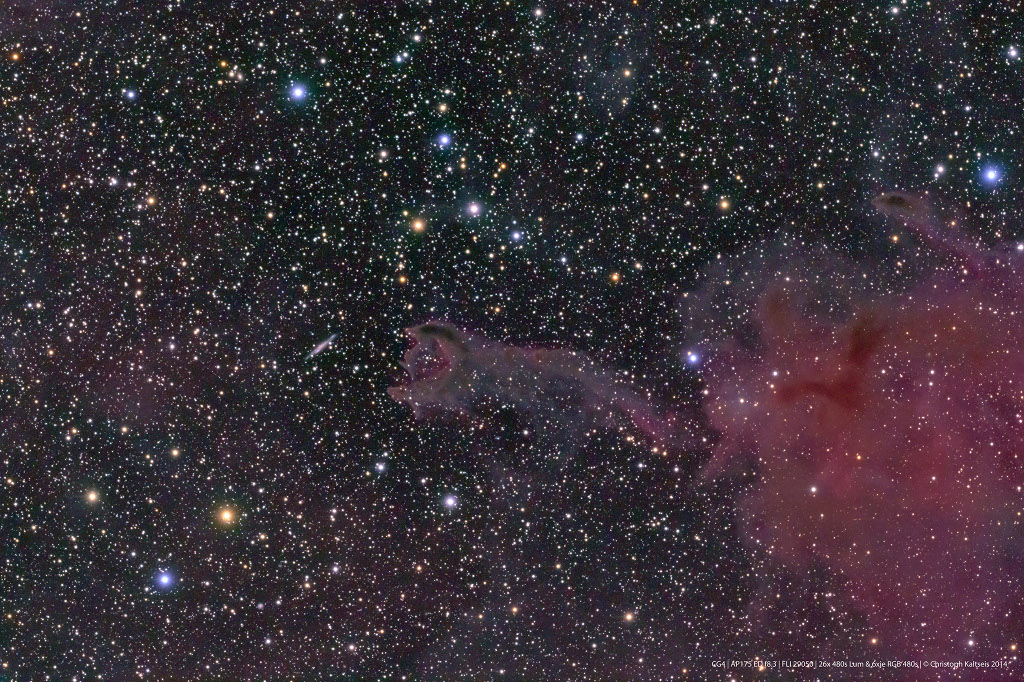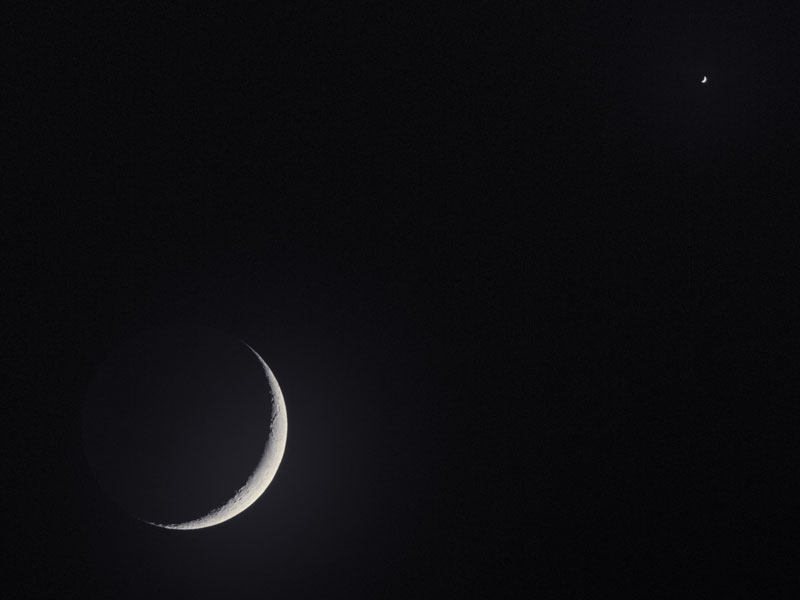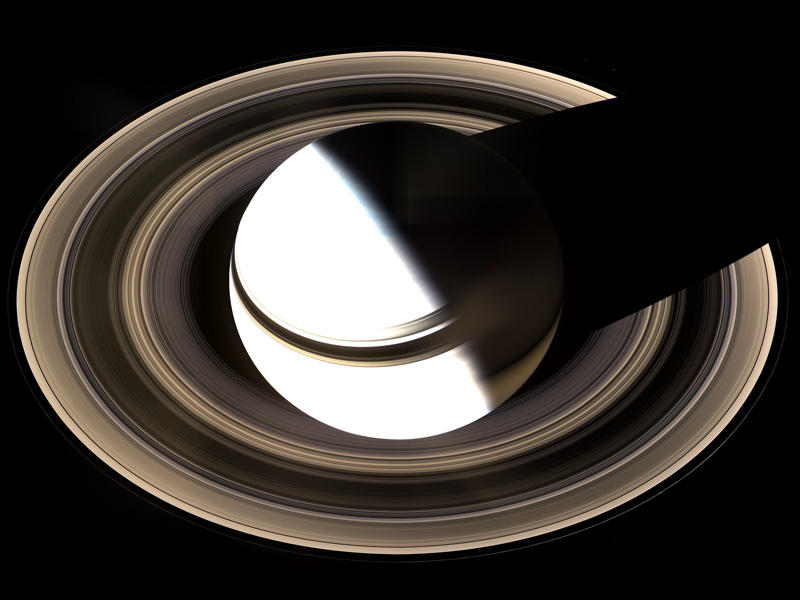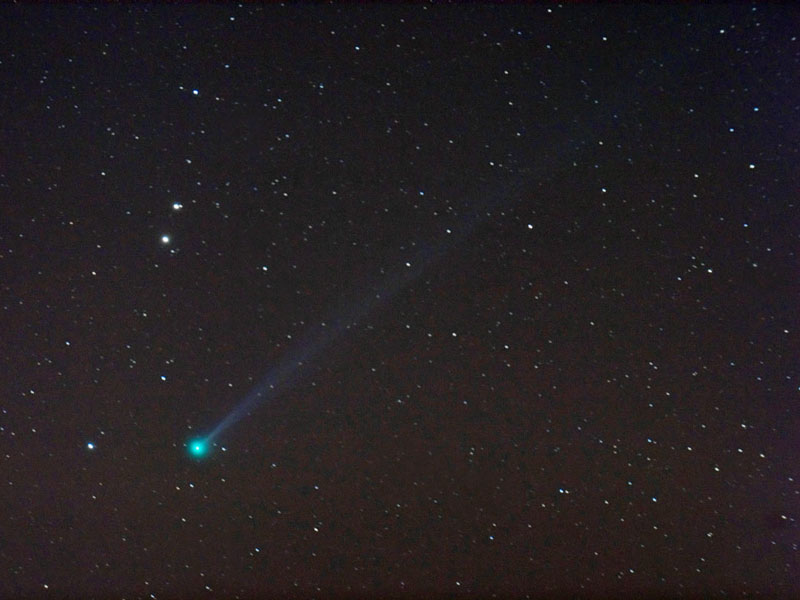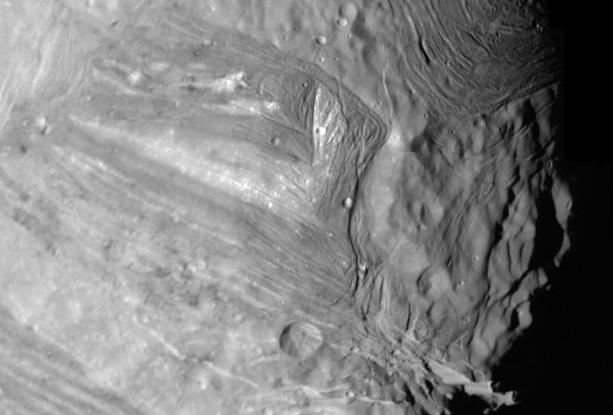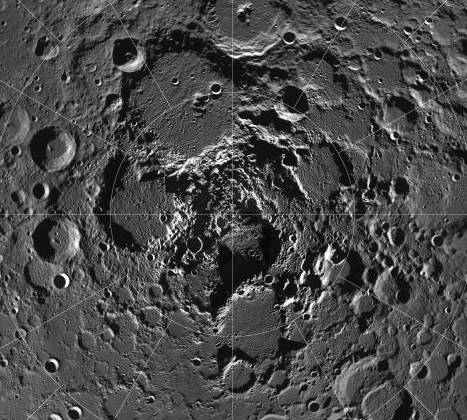| << Previous | Index | Next >> |
2015 The faint and somehow menacing cometary globule CG4 reaches through the center of this deep southern skyscape. About 1,300 light-years from Earth toward the constellation Puppis, its head is about 1.5 light-years in diameter and its tail about 8 light-years long. That's far larger than the Solar System's comets that it seems to resemble. In fact, the dusty cloud contains enough material to form several Sun-like stars and likely has ongoing star formation within. How its distinctive form came about is still debated, but its long tail trails away from the Vela Supernova remnant near the center of the Gum Nebula, while its head could represent the rupture of an originally more spherical cloud. Still, the edge-on spiral galaxy also near picture center is not actually being threatened by CG4. The galaxy lies in the distant background more than 100 million light-years away.
2014 NGC 1333 is seen in visible light as a reflection nebula, dominated by bluish hues characteristic of starlight reflected by dust. A mere 1,000 light-years distant toward the heroic constellation Perseus, it lies at the edge of a large, star-forming molecular cloud. This striking close-up view spans about two full moons on the sky or just over 15 light-years at the estimated distance of NGC 1333. It shows details of the dusty region along with hints of contrasting red emission from Herbig-Haro objects, jets and shocked glowing gas emanating from recently formed stars. In fact, NGC 1333 contains hundreds of stars less than a million years old, most still hidden from optical telescopes by the pervasive stardust. The chaotic environment may be similar to one in which our own Sun formed over 4.5 billion years ago.
2013 Is this an alien? Probably not, but of all the animals on Earth, the tardigrade might be the best candidate. That's because tardigrades are known to be able to go for decades without food or water, to survive temperatures from near absolute zero to well above the boiling point of water, to survive pressures from near zero to well above that on ocean floors, and to survive direct exposure to dangerous radiations. The far-ranging survivability of these extremophiles was tested in 2011 outside an orbiting space shuttle. Tardigrades are so durable partly because they can repair their own DNA and reduce their body water content to a few percent. Some of these miniature water-bears almost became extraterrestrials recently when they were launched toward to the Martian moon Phobos on board the Russian mission Fobos-Grunt, but stayed terrestrial when a rocket failed and the capsule remained in Earth orbit. Tardigrades are more common than humans across most of the Earth. Pictured above in a color-enhanced electron micrograph, a millimeter-long tardigrade crawls on moss.
2012 Is this a painting or a photograph? In this beautiful celestial still life composed with a cosmic brush, dusty nebula NGC 2170 shines near the image center. Reflecting the light of nearby hot stars, NGC 2170 is joined by other bluish reflection nebulae, a red emission region, many dark absorption nebulae, and a backdrop of colorful stars. Like the common household items still life painters often choose for their subjects, the clouds of gas, dust, and hot stars pictured above are also commonly found in this setting - a massive, star-forming molecular cloud in the constellation of the Unicorn (Monoceros). The giant molecular cloud, Mon R2, is impressively close, estimated to be only 2,400 light-years or so away. At that distance, this canvas would be over 60 light-years across.
2011 Rocks from space hit Earth every day. The larger the rock, though, the less often Earth is struck. Many kilograms of space dust pitter to Earth daily. Larger bits appear initially as a bright meteor. Baseball-sized rocks and ice-balls streak through our atmosphere daily, most evaporating quickly to nothing. Significant threats do exist for rocks near 100 meters in diameter, which strike the Earth roughly every 1000 years. An object this size could cause significant tsunamis were it to strike an ocean, potentially devastating even distant shores. A collision with a massive asteroid, over 1 km across, is more rare, occurring typically millions of years apart, but could have truly global consequences. Many asteroids remain undiscovered. In fact, one was discovered in 1998 as the long blue streak in the above archival image taken by the Hubble Space Telescope. In 2002 June, the small 100-meter asteroid 2002 MN was discovered only after it whizzed by the Earth, passing well within the orbit of the Moon. 2002 MN passed closer than any asteroid since 1994 XM1, but not as close as 2004 MN4 will pass in 2029. A collision with a large asteroid would not affect Earth's orbit so much as raise dust that would affect Earth's climate. One likely result is a global extinction of many species of life, possibly dwarfing the ongoing extinction occurring now.
2010 Reddened light from the setting Sun illuminates the cloud banks hugging this snowy, rugged terrain. Inspiring a moment of quiet contemplation, the sunset scene included a remarkable pillar of light that seemed to connect the clouds in the sky with the mountains below. Known as a Sun pillar, the luminous column was produced by sunlight reflecting from flat, six-sided ice crystals formed high in the cold atmosphere and fluttering toward the ground. Last Monday, astronomers watched this Sun pillar slowly fade, as the twilight deepened and clearing, dark skies came to Mt. Jelm and the Wyoming Infrared Observatory.
2009 Last Friday, the Moon and Venus shared the early evening sky in a beautiful conjunction. Separated by only about 2 degrees, they also were both in a crescent phase. Just like our Moon, Venus can appear as a full disk or a thin crescent. Frequently the brightest object in the post-sunset or pre-sunrise sky, Venus is so small that it usually requires binoculars or a small telescope to clearly see its phase. This telescopic image of Friday's conjunction shows off the similar crescent phases, with the tiny crescent Venus at the upper right.
2008 The plane of our Milky Way Galaxy runs through this complex and beautiful skyscape. At the northwestern edge of the constellation Vela (the Sails) the 16 degree wide, 30 frame mosaic is centered on the glowing filaments of the Vela Supernova Remnant, the expanding debris cloud from the death explosion of a massive star. Light from the supernova explosion that created the Vela remnant reached Earth about 11,000 years ago. In addition to the shocked filaments of glowing gas, the cosmic catastrophe also left behind an incredibly dense, rotating stellar core, the Vela Pulsar. Some 800 light-years distant, the Vela remnant is likely embedded in a larger and older supernova remnant, the Gum Nebula. The broad mosaic includes other identified emission and reflection nebulae, star clusters, and the remarkable Pencil Nebula.
2007 This image of Saturn could not have been taken from Earth. No Earth based picture could possibly view the night side of Saturn and the corresponding shadow cast across Saturn's rings. Since Earth is much closer to the Sun than Saturn, only the day side of the planet is visible from the Earth. In fact, this image mosaic was taken in January by the robotic Cassini spacecraft now orbiting Saturn. The beautiful rings of Saturn are seen in full expanse, while cloud details are visible near the night-day terminator divide.
2006 Have you ever seen a comet? Comets bright enough to be visible to the unaided eye appear only every few years. Right now, however, a new comet has brightened unexpectedly and is visible as a faint streak to the unaided northern observer in the eastern morning sky just before sunrise. Binoculars may help. Comet Pojmanski, officially designated C/2006 A1 and discovered only in January, now sports a turquoise tail several times longer than the full moon. Comet Pojmanski's ion tail is due to gas particles expelled by the comet being pushed away from the Sun by the solar wind, the same wind that ionizes gas in the tail causing its blue tint. Pictured above as it appeared only last week, Comet Pojmanski has now begun to fade as its orbit around the Sun takes it further from the Earth.
2005 What would it be like to stand atop the tallest mountain on Earth? To see a full panoramic vista from there, scroll right. Visible are snow peaked mountains near and far, tremendous cliffs, distant plateaus, the tops of clouds, and a dark blue sky. Mt. Everest stands 8.85 kilometers above sea level, roughly the maximum height reached by international airplane flights, but much less than the 300 kilometers achieved by a space shuttle. Hundreds of people have tried and failed to climb the behemoth by foot, a feat first accomplished successfully in 1953. About 1000 people have now made it to the summit. Roddy Mackenzie, who climbed the mountain in 1989, captured the above image. Mt. Everest lies in the Himalayan mountains in the country of Nepal. In the native language of Nepal, the mountain's name is "Sagarmatha" which means "forehead of the sky."
2004 Scattered debris from a cosmic supernova explosion lights up the sky in this gorgeous composited image based on data from the Hubble Space Telescope. Cataloged as N49, these glowing filaments of shocked gas span about 30 light-years in our neighboring galaxy, the Large Magellanic Cloud. Light from the original exploding star reached Earth thousands of years ago, but N49 also marks the location of another energetic outburst -- an extremely intense blast of gamma-rays detected by satellites only twenty-five years ago on March 5, 1979. That date was the beginning of an exciting journey in astrophysics which led researchers to the understanding of an exotic new class of stars. The source of the March 5th Event is now attributed to a magnetar - a highly magnetized, spinning neutron star also born in the ancient stellar explosion which created supernova remnant N49. The magnetar hurtles through the supernova debris cloud at over 1,200 kilometers per second.
2003 After last month's dramatic swoop past the Sun, Comet NEAT (C/2002 V1) appeared as a naked-eye comet, emerging from the evening twilight in planet Earth's southern skies. On March 1st, New Zealand photographer Noel Munford captured this telephoto view of the outbound comet close to the southwestern horizon against the faint stars of the constellation Sculptor. He reports that the picture is a good representation of the comet's visual appearance on that date and estimates the impressive tail to be five or six degrees long. Discovered last November as part of the Near-Earth Asteroid Tracking program, there was some speculation that this comet would not survive its close encounter with the Sun. However, Comet NEAT is now returning to the outer solar system, diving southward and fading fast.
2002 Stunningly detailed, this picture is a computer simulated view of a cluster of galaxies in the distant cosmos. A large, elliptical galaxy dominates this hypothetical cluster's central region surrounded by a swarm of member galaxies. Other galaxies which lie far behind the cluster are seen as numerous visible concentric arcs - lensed by the enormous gravitational field dominated by dark matter within the cluster itself. Such magnificent images are expected to be achieved by the Advanced Camera for Surveys (ACS), one of the upgrades being installed on the Hubble Space Telescope during the ongoing servicing mission. Compared to Hubble's workhorse Wide Field Planetary Camera 2 (WFPC2), whose achievements include the current deep field views of the Universe, the new technology ACS will be twice as sharp an imager with twice the field of view and five times the sensitivity. Along with extended views of the distant cosmos, enthusiastic astronomers also plan to use the ACS to monitor our own Solar System and to search for planets orbiting stars beyond the Sun.
2001 The first hint of what will become of our Sun was discovered inadvertently in 1764. At that time, Charles Messier was compiling a list of "annoying" diffuse objects not to be confused with "interesting" comets. The 27th object on Messier's list, now known as M27 or the Dumbbell Nebula, is a planetary nebula, the type of nebula our Sun will produce when nuclear fusion stops in its core. M27 is one of the brightest planetary nebulae on the sky, and can be seen in the constellation Vulpecula with binoculars. It takes light about 1000 years to reach us from M27, shown above in representative colors. Understanding the physics and significance of M27 was well beyond 18th century science. Even today, many things remain mysterious about bipolar planetary nebula like M27, including the physical mechanism that expels a low-mass star's gaseous outer-envelope, leaving an X-ray hot white dwarf.
2000 Over the course of billions of years, whole clusters of galaxies merge. Above is an X-ray image of Abell 2142, the result of the collision of two huge clusters of galaxies, and one of the most massive objects known in the universe. This false-color image shows a concentration of gas 50 million degrees hot near the center of the resulting cluster. Oddly, it is the relative coldness of the gas that makes this situation particularly interesting. The center of Abell 2142 is surrounded by gas fully twice as hot, a temperature thought to have been created by energy released during the colossal collision. Still, since we can only see a snapshot in time, much remains unknown about how clusters of galaxies form and coalesce.
1999 Miranda is a bizarre world which surely had a tempestuous past. The innermost of the larger Uranian moons, Miranda is almost 300 miles in diameter and was discovered in 1948 by American planetary astronomer Gerard Kuiper. Examined very closely by the Voyager 2 spacecraft in 1986, this dark and distant world turned out to be quite a surprise. Miranda was found to display a unique, bewildering variety of terrain leading some to suggest that it has been fractured up to 5 times during its evolution. Along with the famous "chevron" feature, the bright V-shaped area just above center, this composite of the highest resolution images of Miranda shows wild juxtapositions of ridges and valleys, older cratered and younger smooth surfaces, and shadowy canyons perhaps 12 miles deep. The large crater (below center) is the 15 mile wide crater Alonso.
1998 After seven weeks in lunar orbit, instruments on board NASA's Lunar Prospector spacecraft have produced strong evidence for water ice on the Moon. While not in extensive sheets, this ice could be in the form of crystals, mixed in low concentrations with material in craters around the frigid North and South lunar poles. How much ice? So far, the estimates are from 10 to 300 million metric tons (about 3 to 90 billion gallons). The water ice is likely a result of meteoritic and cometary bombardment. Using very different instruments, the Star-Wars-technology Clementine spacecraft also detected telltale signs of ice as it orbited the Moon in 1994. Although the lunar samples returned by the Apollo missions suggested that the Moon was bone dry, the Clementine result sparked the controversy and hope that water ice might still be found - holding out the tantalizing possibility that a substantial reservoir of lunar water could be used to support human exploration. Above is a mosaic of Clementine images of the cratered terrain surrounding the Moon's North pole. Surprisingly, Lunar Prospector's data indicates that the North polar region contains about twice as much ice as the South. As Lunar Prospector's mission continues, further data will help determine more precisely the amount and distribution of the water ice.
1997 Why put observatories in space? Most telescopes are on the ground. On the ground, you can deploy a heavier telescope and upgrade it more easily. The trouble is that Earth-bound telescopes must look through the Earth's atmosphere. First, the Earth's atmosphere blocks out a broad range of the electromagnetic spectrum, allowing a narrow band of visible light to reach the surface. Telescopes which explore the Universe using light beyond the visible spectrum, such as those onboard the Compton Observatory (gamma rays), the ASCA satellite (x-rays), or the new ultraviolet and infrared instruments on the above-pictured Hubble Space Telescope (HST), need to be carried above the absorbing atmosphere. Second, the Earth's atmosphere blurs the light it lets through. The blurring is caused by varying density and continual motion of air. By orbiting above the Earth's atmosphere, the Hubble can get clearer images. In fact, even though HST has a mirror 15 times smaller than large Earth-bound telescopes, it can still resolve detail almost 100 times finer.
1996 SS433 is one of the most exotic star systems known to astronomers. Its unremarkable name stems from its inclusion in a catalog of stars which emit radiation characteristic of atomic hydrogen. Its very remarkable behavior stems from a compact object, a black hole or neutron star, which has produced an accretion disk with jets. As illustrated in this artist's vision of the SS433 system based on observational data, a massive, hot star (left) is locked in a mutual orbit with a compact object. Material transfers from the massive star into an accretion disk surrounding the compact object blasting out two jets of ionized gas in opposite directions - at about 1/4 the speed of light! Radiation from the jet tilted toward the observer is blueshifted, while radiation from the jet tilted away is redshifted. The binary system itself completes an orbit in about 13 days while the jets precess (wobble like a top) with a period of about 164 days. Are the jets from SS433 related to those from black holes at the centers of galaxies?
| << Previous | Index | Next >> |
